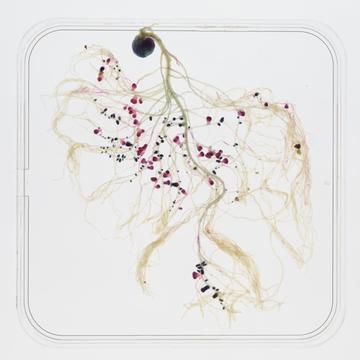New research has revealed that soil microbes – rhizobia – sense and respond to chemical signals and nutrients at various stages of symbiosis with legume plants.
Symbiosis between legumes and rhizobia bacteria is beneficial to both and is essential for the supply of nitrogen to these important crops. Nitrogen is one of the primary limiting nutrients for plant growth and crop productivity and so understanding the molecular processes responsible for the establishment of this symbiosis as well as how well these bacteria survive in the soil will allow us to design efficient soil improvements such as bioinoculants that lead to sustainable crop yields in the future.
The research led by the Department of Biology, University of Oxford, optimised a cell tracking pipeline to determine the motility parameters of rhizobia in free-living conditions. The study showed how rhizobia respond to different carbon sources and demonstrated the importance of motility and chemotaxis systems (the movement of the bacteria in response to a chemical stimulus). Soil is a complex environment for microbial motility and the region of the soil surrounding the plant roots (called rhizosphere) is a critical place for both plant–microbe interactions and nutrient exchange. These interactions are strongly influenced by chemically complex carbon compounds produced by the plant and released from roots into the soil (called exudates). The bacterial response to these exudates is strongly dependent on the different chemical receptors and soil bacteria are known for having a high number of these sensing mechanisms. This study shows how rhizobia follow this pattern, with 27 chemical receptors.

A pea root with nodules that are two different colours. These represent two strains of rhizobia competing for nodulation - the result of a competition assay.
The high number of chemical receptors used to control bacterial motility helps rhizobia to sense and reach the best energy sources in this complex environment. In the soil, rhizobia swim towards the plant root surface in response to chemical stimulus, where they engage in a molecular dialogue with the plant and colonize the root by complex signalling and attraction processes. If successful, this recognition between the two partners enables their entrance into the root hair, forming a nodule where they differentiate into nitrogen-fixing bacteroids. The study found therefore that both motility and chemotaxis are important for bacterial competitiveness in the soil as well as for nodule development in the plant, and it has determined which chemotaxis genes have roles in each of these important processes. In this case the Che1 cluster, in coordination with flagella (which is the appendage that spins and pushes the cell forward), has a role in free-living motility and nodule competition, and is key prior to establishment of the symbiosis whereas the Che2 cluster is more important afterwards, once rhizobia form the nodule, influencing the development of symbiotic cells and nodule maturation.
Intriguingly a novel system for bacterial movement that responds in such a way as to halt motility has also been reported in this study. This motility brake is independent of the standard sensing mechanisms mediated by chemotaxis systems and instead responds to organic acids.
Dr Carmen Sánchez-Cañizares says of the study
''The effectiveness of rhizobial inoculants in the field relies on their motility and dispersal through soil, as they can achieve a growth advantage by arriving and establishing themselves at the root surface before others do. Therefore, how soil bacteria respond to nutrients and how these chemotaxis and motility systems influence their symbiotic behaviour at different stages of the symbiosis is of crucial importance for their survival and adaptation both in soil and when interacting with their legume hosts.''
The work was part of the research of PhD student and first author Samuel Aroney. Professor Philip Poole, co-author and supervisor says
''It was a privilege to support Sam in the two major findings of this study. Two chemotaxis systems were determined which are critical to the competitiveness of rhizobia to induce formation of nodules as well as fix nitrogen and are prime determinants of why some rhizobia will be more or less successful than others. This work will contribute to improving soil for higher crop yields in the future.''
Further investigation into the many chemoreceptors present in rhizobia and the regulation of motility will enable the creation of rhizobial inoculants with better survival rates in the soil that also strongly associate with targeted crop plants. This will improve crop yields with little negative environmental impact, providing the expanded population with a sustainable and secure supply of food.
The work was supported by grants from the BBSRC and The Leverhulme Trust, led by Prof. Philip Poole, the BBSRC Doctoral Training Partnership programme at Oxford for Samuel Aroney, and a University Research Fellowship by The Royal Society awarded to Carmen Sánchez-Cañizares.
The study was published in Environmental Microbiology, an Applied Microbiology International publication and it features in The Microbiologist magazine.